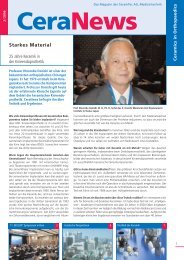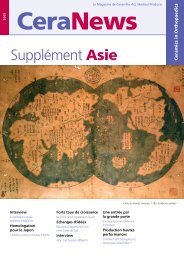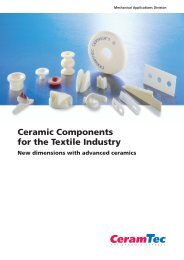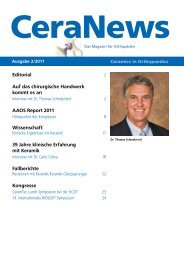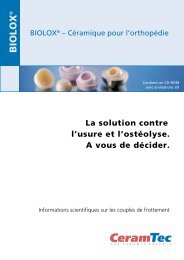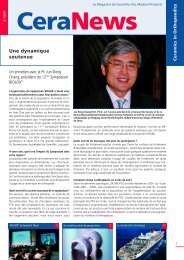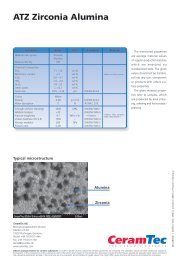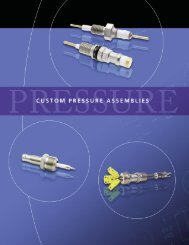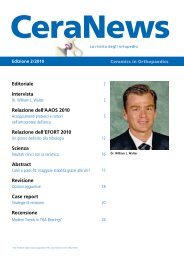Download PDF, 2.4 MB - CeramTec
Download PDF, 2.4 MB - CeramTec
Download PDF, 2.4 MB - CeramTec
You also want an ePaper? Increase the reach of your titles
YUMPU automatically turns print PDFs into web optimized ePapers that Google loves.
10-year results with MoM THAin 1,121 patientsFabian von Knoch (Switzerland) reported on radiologicaland clinical results from 1,270 MoM THA(28mm, high carbon).Between 1994 and 2004, 1,121 patients (57%male, 43% female) underwent surgery mainly totreat primary osteoarthritis (80%) in one institution.After a mean follow-up of 6.8 years, theprobable survival rate was determined (using theKaplan-Meier method). This was 91% after 10years for the acetabular cup and 96% for thefemoral stem. The reasons for revision includedaseptic loosening in 63 cases (5%), infections in 8cases, periprosthetic fractures in 8 cases, dislocationin 8 cases, pain of unclear origin in 7 cases andacetabular cup fractures in 4 cases. The study didnot identify any significant influence on longevityfrom demographic factors, implantation factors, orsurgi cal techniques.Von Knoch concluded that the second generationMoM bearing couple does not offer any majoradvantages over other bearing couples, but is associatedwith the risk of potentially harmful metal ionlevels and can therefore only be recommended withprovisos.Ultrasound diagnostics for MoMbearing couples with ARMDFor a conversant user, ultrasound is a reliable, noninvasiveand cost effective method for the detectionof ARMD.According to Singisetti, diagnostic ultrasound isused routinely in his clinic as a screening methodfor patients with complaints of an unclear natureafter MoM implantation.8.5-year results with MoM, MoP andCoC bearing couples in a hip systemIngrid Milosev (Slovenia) reported on results withMoM (low carbon), MoP and CoC (BIOLOX ® forte)bearing couples implanted in 474 patients in 487THA performed between 01/2000 and 12/2002.The modular acetabular cup and femoral stem wereidentical in all cases. After a mean follow-up of 8.5(6.9–9.9) years, the overall revision rate was 3.7%.The revision rate was 8.7% for MoM, 4.1% for CoCand 1.5% for MoP. The MoM group had the highestrevision rate due to aseptic loosening.In the CoC group, patients mainly experiencedsecondary insert fractures due to improper handlingwhen the liner was inserted into the cup.To conclude, the MoP bearing couple can be recommendedas a solution for older, less active patients,while the CoC couple is recommended for youngeractive patients.It was noted from the audience that the CoC THAused in this study was one with a sandwich design.Various diagnostic imaging procedures areused to investigate complaints of an unclearnature after MoM implantation. The efficacyof diagnostic ultrasound in cases of ARMDhas been demonstrated for the first time in arecent study.Kiran Singisetti (UK) started by explaining theproblems associated with ARMD. The complexpathogenetic mechanisms require further research,but diagnostic assessment also presents difficulties.Ultrasound diagnostics was evaluated in a studywhich involved 35 patients in whom ARMD wasconfirmed clinically and histologically after MoMbearing couple implantation. Extra-articular fluidaccumulation was present in 33 (94.3%) of thepatients; in most cases this was found in combinationwith iliopsoas and trochanteric bursitis. Extraarticularechogenic responses were detected in 31(88.6%) of the patients. Over a period of severalmonths, progression of the changes was observedin 5 patients, while 1 patient was found to haveconverted from non-echogenic to echogenic jointeffusion.Immunological reactions: comparisonof MoM and CoP bearing couplesHypersensitivity reactions to metal wear arereported as a cause of osteolysis associated withMoM bearing couples. Evidence-based data fora correlation of this nature remains insufficientfor low-carbon MoM bearing couples.In this respect, studies of retrieved implants conductedby Thomas Repantis (Greece) have providednew findings. He analyzed retrieved implantsfrom 20 MoM bearing couples (low carbon) and 13CoP bearing couples for a hypersensitivity immuneresponse in the periprosthetic tissue. The reason forall of the revisions was aseptic loosening. Controlsamples from primary implantations and tissue samplesfrom the revisions were subjected to histologicaland immunohistochemical analysis.The 13 CoP bearing couples did not exhibit anyparti cular reactions.The 20 MoM bearing couples (low carbon) exhibitedextensive necrotic areas and fibrin exudates,which were not to be found in either the CoP bearingcouples or the control samples. Diffuse perivas-CeraNews 1/201215



